Review
Bauer Supreme shifts back from evolution to revolution
with bold new UltraSonic knee stack
by Kevin Woodley
At first glance, you might mistake Bauer’s new UltraSonic pad for a refresh of their Supreme 2S Pro model, with new and updated strapping options and a bold graphic that really pops.
But there is a reason Bauer didn’t simply call the new Supreme pad 3S Pro.
When you take a closer look at the completely re-designed knee-stack, it becomes immediately evident why the latest step in the Supreme line is more revolution than evolution, and why it was necessary to come up with a new name befitting this dramatic change.
Bauer’s designers integrated the knee stack into the face of the pad, effectively creating a one-piece unit to eliminate any rotation issues and improve the seal and stability in the UltraSonic pad. They’re calling it their Stabilislide knee and it made an immediate impression on the five InGoal Magazine testers that got to take it on the ice before the Coronavirus brought hockey to a halt, not to mention Swedish super prospect Jesper Wallstedt and reigning Vezina Trophy winner Andrei Vasilevskiy, who switched after one try and used it for the past month.
The plan at InGoal was to talk to Vasilevskiy about his decision to make such a significant switch mid-season when the Tampa Bay Lightning visited Vancouver, but the NHL put its season on pause because of the Coronavirus pandemic five days before they were due to arrive.
Fortunately for us, playing partner Curtis McElhinney was also struck by how well the new Stabilislide knee worked for Vasilevskiy, so much so he’ll consider adding it to his next set.
“After watching Vasy with it, I may,” McElhinney said. “He had zero pad rotation once he made the switch and they seemed to hit the ice so flush. That knee block was legit.”
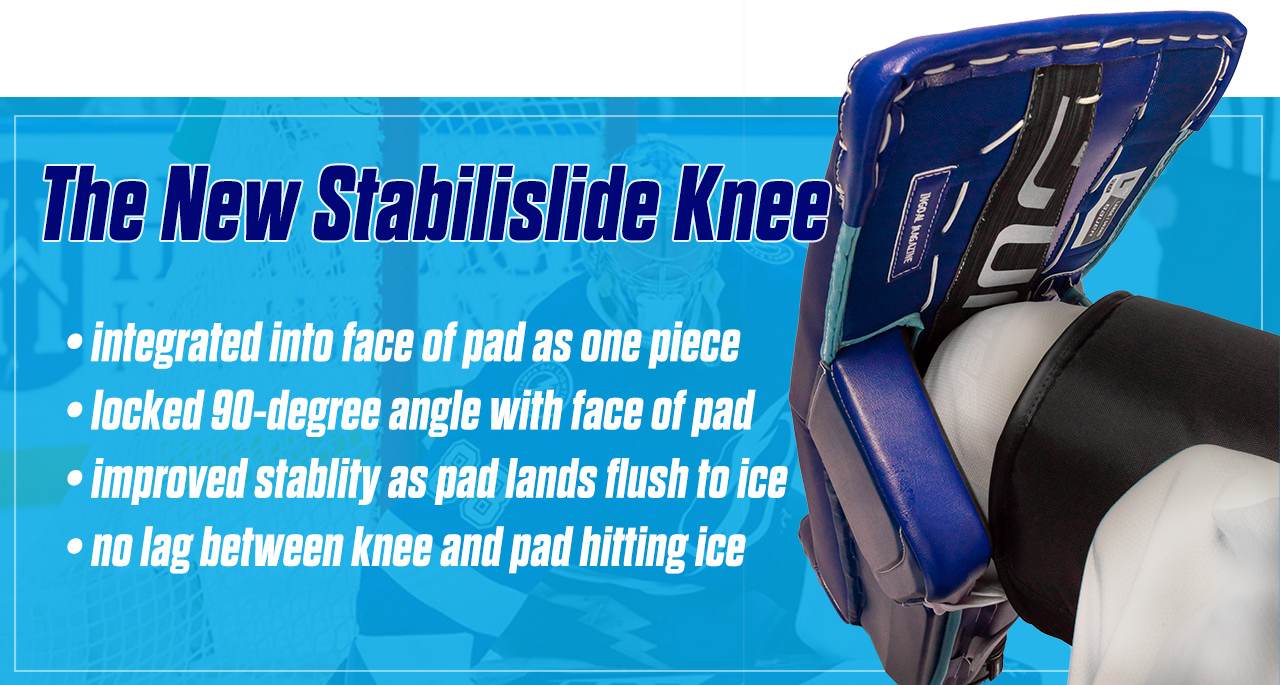
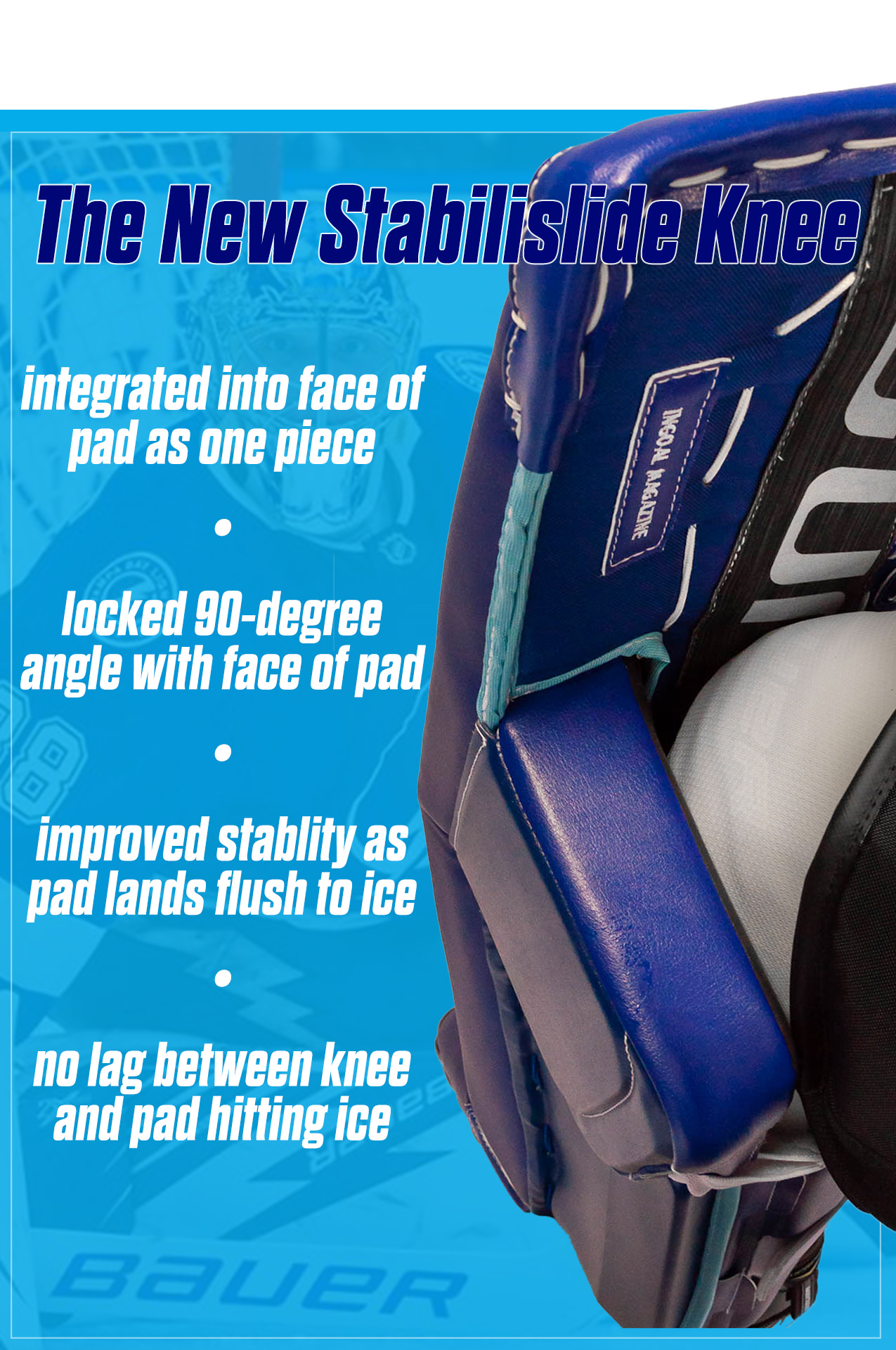
Wallstedt, who earlier this season became the youngest goaltender to play in the top tier Swedish Hockey League (SHL) at age 17, echoed those sentiments.
“I absolutely love the new knee,” Wallstedt, who is the early favorite to be first goalie picked at the 2021 NHL Draft, wrote in a message to InGoal. “I know that it’s a personal preference but for me it fits perfect into my kind of playing style on the ice. The whole pad lays so flat and covers the whole ice. I have used it a couple months and absolutely love them.”
Those are the broad strokes, and they bode well for the Bauer’s new UltraSonic set up. Now, let’s get into the nitty gritty of how and why the new Stabilislide knee works — our testers think the benefits go beyond seal and stability — and who the new line is best suited for.
InGoal Radio Podcast presented by The Hockey Shop Source for Sports on the Ultrasonic Pads
We looked at the Ultrasonic pads on the InGoal Radio Podcast presented by The Hockey Shop Source for Sports Episode 86 with feature guest Connor Hellebuyck. Use the link above to hear just the gear segment or you can listen to the full episode here.
Sticking with the new knee, the visual difference is actually pretty subtle. Other than attaching the elastic knee wrap to a flap on the outer edge and a rich-looking, almost stylish — and more durable — new material on the landing area itself, the use of binding around the inner edge of the knee stack area makes it hard to tell that anything is different. Try to flex that knee stack, however, and the change becomes as unmistakable as the new name.
It is firm and fixed, locked into that 90-degree angle with the face of the pad.
Bauer’s intent was improving stability by ensuring the pad lands and stays flush and stable even if the goalie didn’t hit the middle of the knee stack every time. Based on the early feedback from our testers, not to mention Vasilevskiy, McElhinney and Wallstedt, they nailed the stability component. The UltraSonic pad lands with an audible thud and stays flush to the ice.
There are, of course, other benefits. InGoal didn’t shy away from concerns about the floppiness of the original 1S knee stack because the force of a goalie driving to the ice created a situation where the knee would get pushed below the leading edge of the pad, meaning the knee reached the ice before the rest of the pad could catch up and seal it. Bauer made significant improvements in that regard with Vapor 1X Pro the following year and continued those into subsequent Supreme 2S and Vapor 2X pads, but this takes it to an unprecedented level by eliminating any lag between the knee and pad reaching the ice. And, while Bauer’s intent was purely about stability, it’s hard not to think back to the studies CCM has done on how a goalie driving down to the ice in a butterfly can actually create separation between their knee and the pad, allowing the pad to reach the ice even faster. If strapped properly, this fixed relationship between the UltraSonic knee stack and pad should eliminate any give in that initial drive into the knee, possibly improving that separation from the goalie’s knee on the way down.
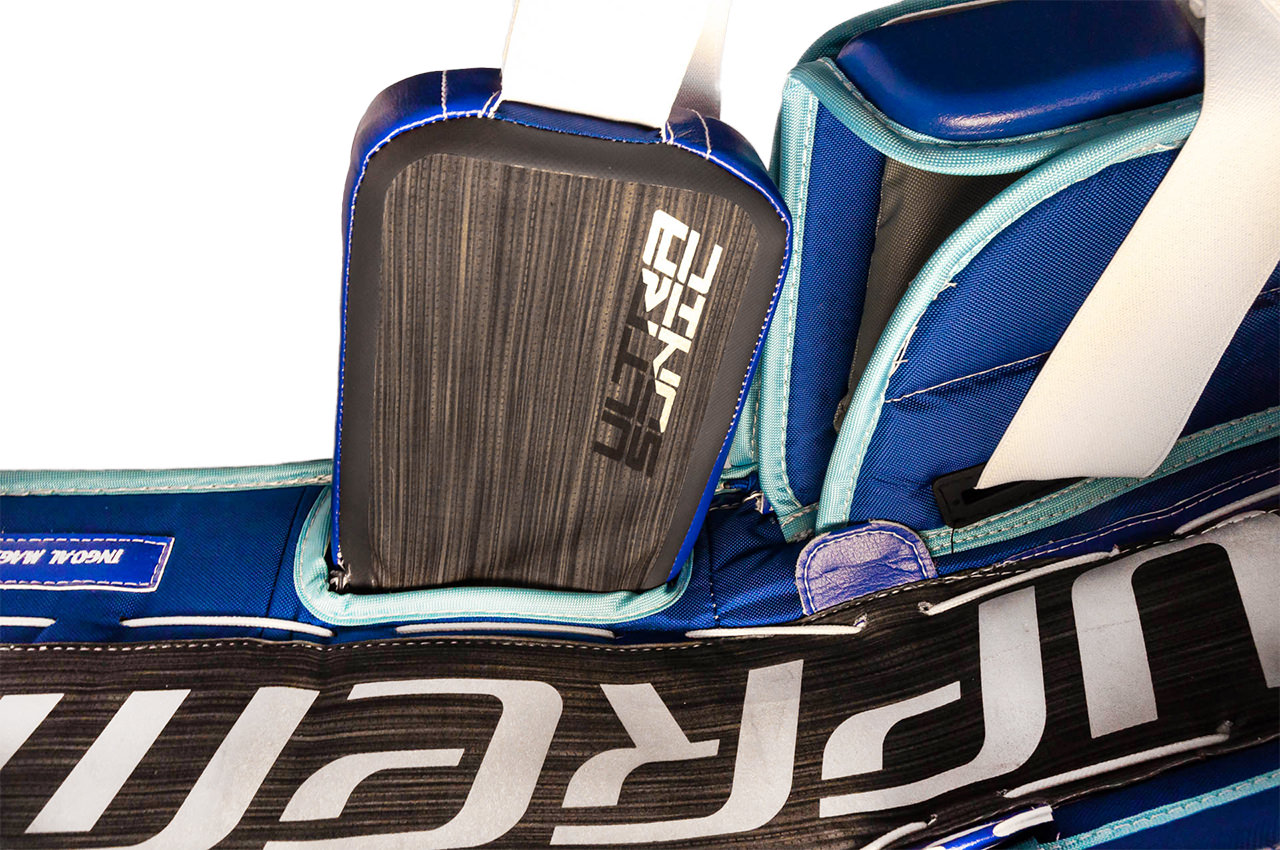
What about sliding?
Of course, anything that improves seal also places more of the pad in firmer contact with the ice, and we immediately wondered if that might negatively affect the fast-sliding properties associated with Bauer since the original OD1N Supreme 1S pad debuted in 2016. Raved about by NHL goaltenders, including Cam Talbot, who switched to a Bauer pad but didn’t add the Stabilislide knee to his UltraSonic pad mid-season, that sliding has become a staple.
The good news is it hasn’t appeared to suffer from the improved seal. Although it’s hardly scientific, especially since some of our testers were coming from other brands, the easy sliding continued to be a feature cited at the top of the list (alongside rebounds that continue to rocket off the face) of positive attributes by InGoal testers. Wallstedt certainly agreed.
“I think the sliding is great, even on bad ice quality,” said Wallstedt, who previously alternated between Vapor and Supreme lines. “I think it’s better than previous pads.”
So how exactly did they pull that off?
To understand that you have to look a little further down the inside edge of the pad at the hard surface of the inner calf plate that contacts the ice. That calf plate has been offset slightly from the lead edge of the pad, but angles back to a thinner beveled edge, which is what contacts the ice. By creating that gap, Bauer reduced how much of the pad was flush the ice, and could cause extra friction or surface-area resistance while sliding.
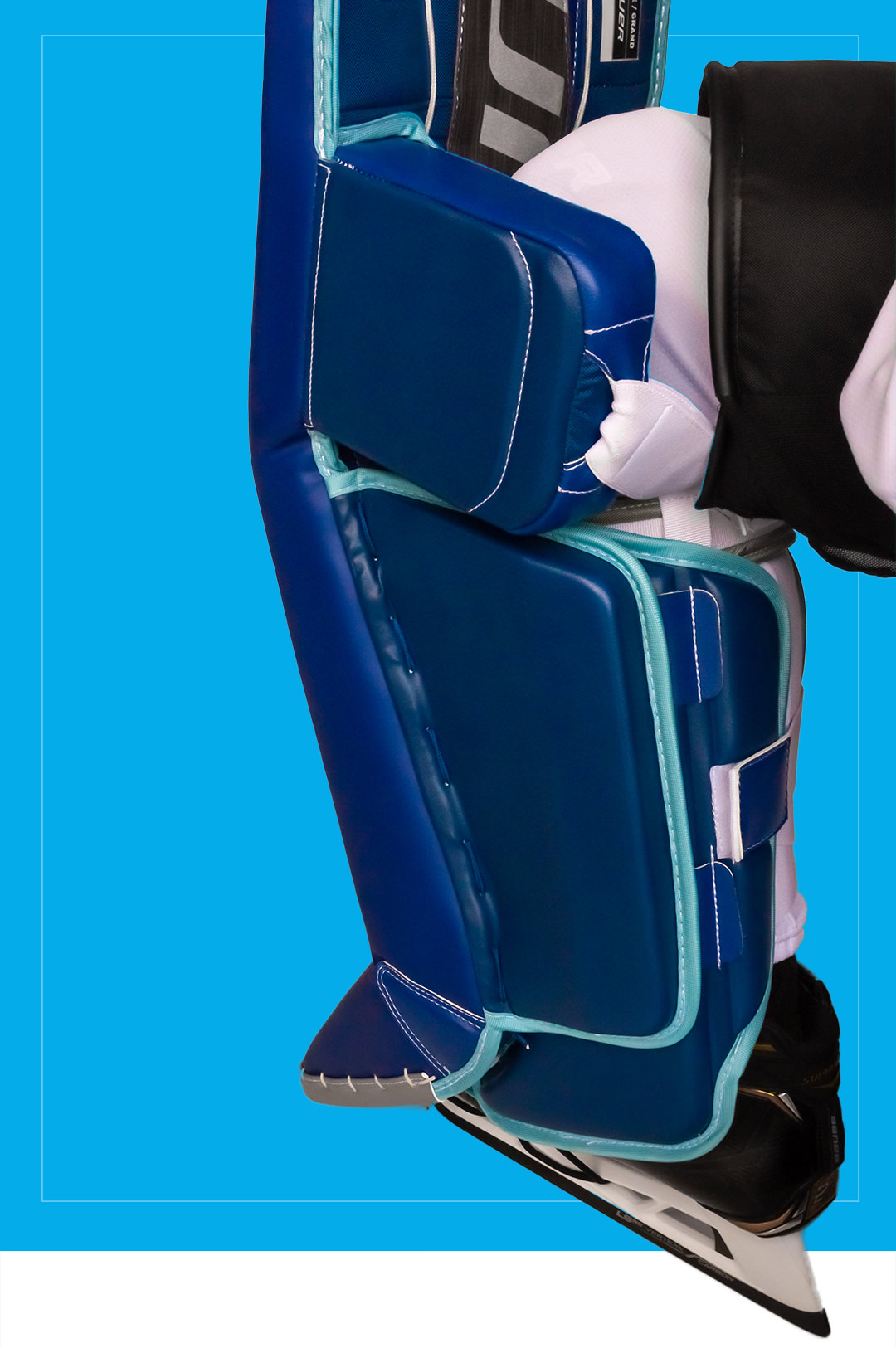
Add in the new (and removable) “butterfly assist calf pillow” that Bauer put on the inside, under the calf, in order to balance out that pressure, and you’ve got the best of both worlds: a better seal without sacrificing sliding.
New Strapping: Tune Fit Connect
Again, we’ll start at the new knee stack. Because the Stabilislide knee doesn’t have three layers attached by Velcro like previous pads of pretty much every make, there was no obvious way to attach the elastic knee strap. So, Bauer created a small tab on the inside edge of the new knee stack, and looped the elastic knee strap through it, adding a Velcro tab on that side to attach it, which provided the extra benefit of being able to adjust the length on that end as well.
With all the twisting and torsion on this strap, and the area it attaches to, it was easy to wonder how well it would wear over time, and indeed Bauer identified these same concerns in early testing samples, and reinforced the material and stitching used to create that tab.
Like previous models, this elastic knee strap is double thick in the middle so it won’t stretch out too easily, and can be attached either down on the outer calf wrap (as Carey Price first did to start that trend), or wrapped around the knee to an outer flap that is not only easily removable with small Velcro tabs, but can also be angled or inset more with two attachment points.
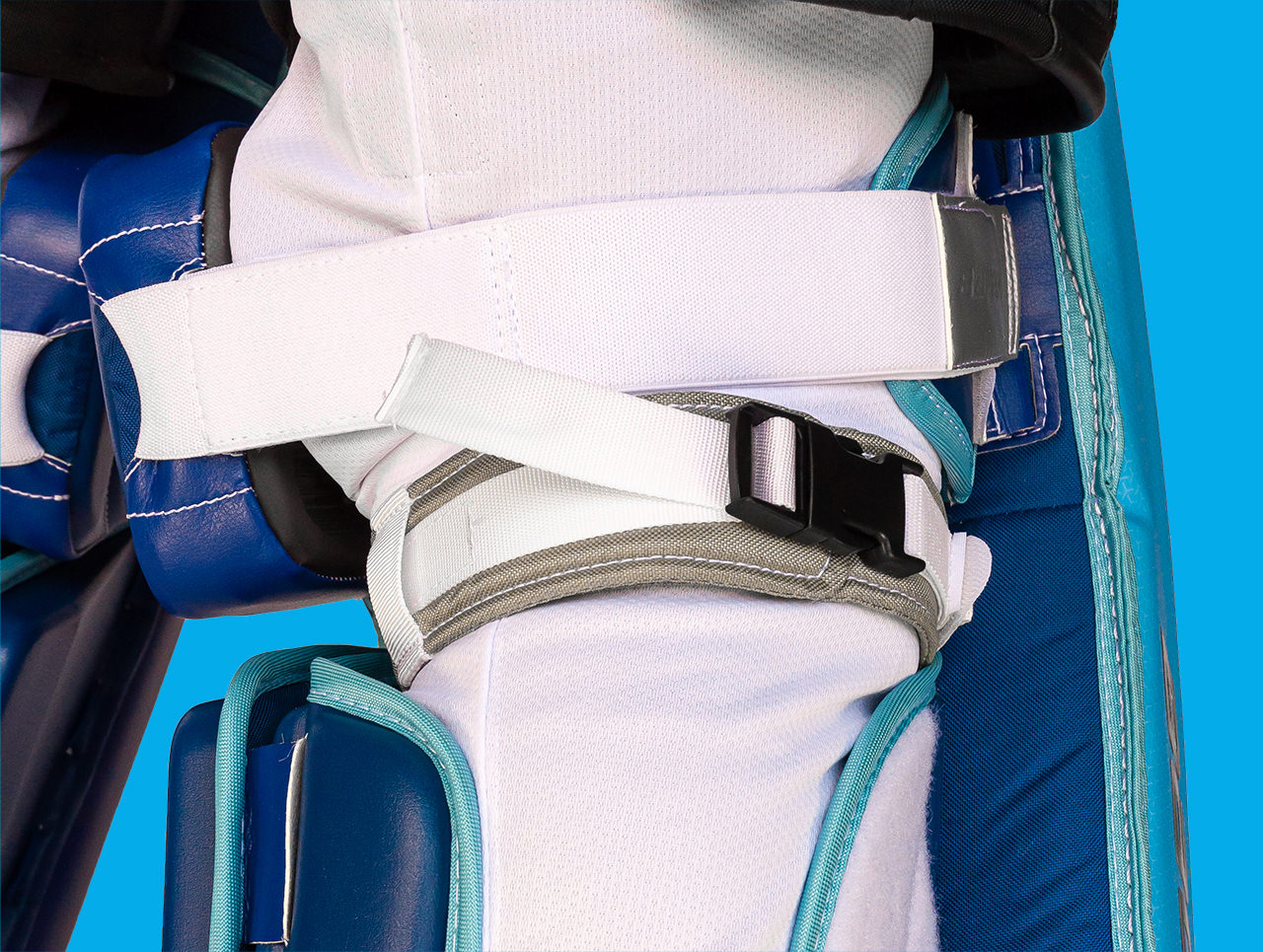
The other big addition to the new Supreme UltraSonic pad is called a Tune Fit Connect strap, but most will recognize it by the more generic name, a “professor strap.” Bauer made this strap, which sits at the top of the calf and can help keep the leg from moving too far away from the knee stack, easily removable with Velcro tabs on either side of the leg channel, and easily adjustable with a combination of Velcro and a nylon strap with a plastic clip.
Continuing down the pad, the CRS strapping on previous Supreme lines is gone, replaced by the Tune-Fit system used on the Vapor line (and chosen by NHL goalies like Devan Dubnyk for his Supreme 2S Pro pads) that had InGoal testers raving about the unique adjustability and ability to dial in how connected the calf felt — and where you felt that connection — based on where you attached the Tune-Fit tab on the outer calf wrap (high = tighter; lower = looser).
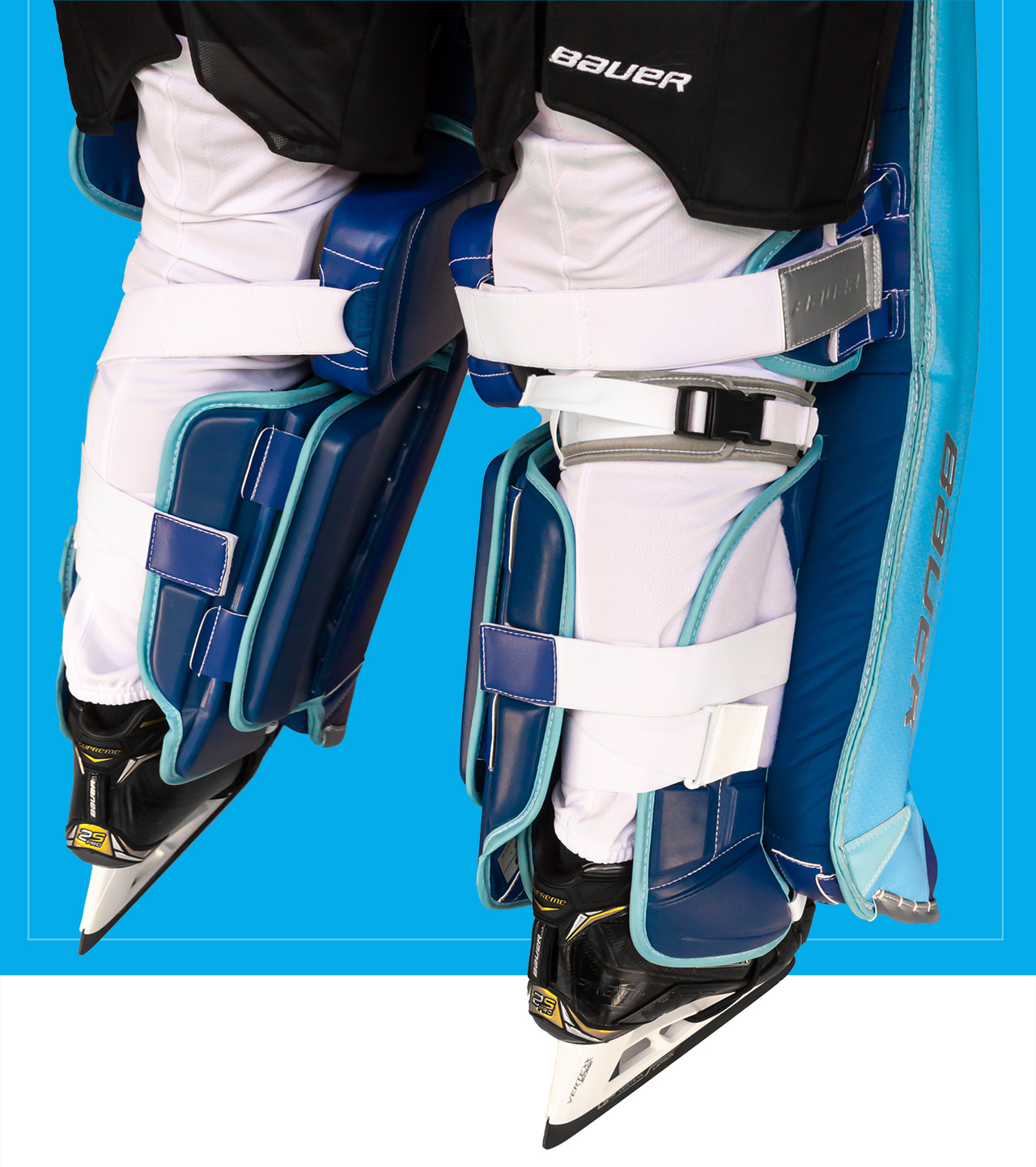
Rounding out the strapping is the continued use of the elastic-and-Velcro toe tie system that debuted on the Vapor 2X Pro pad, and comes in offset position towards the inside edge (it can be custom ordered in a centered position). This bungee-style system, which has become popular across most brands, has enough flex for the skate to easily get to the ice while down in the butterfly (again, making it easier to grab a push edge from your knees), but the elasticity helps pull and rotate the pad back over the middle of the skate when the goalie gets back up. In other words, it enhances that connected feeling, providing the range of motion goaltender used to achieve by tying knots into their lace toe ties without adding the sloppiness of that gap.
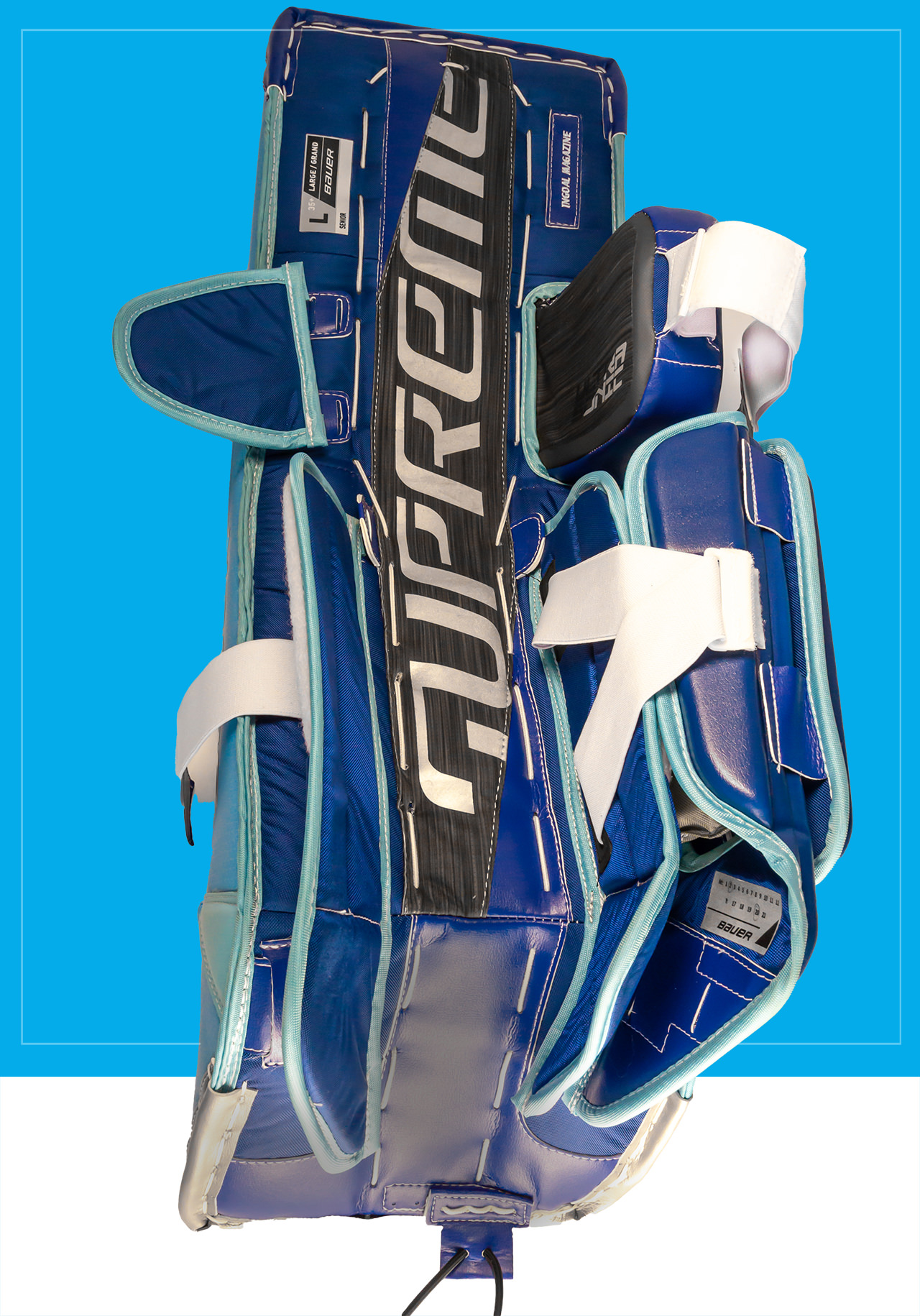
Flex Profile: More Options But Stiffer, Straighter Stock
The stock profile of the new Supreme UltraSonic pad seems noticeably straighter and stiffer than its predecessor, the 2S Pro. It may have a lot to do with how many games InGoal testers have put our Supreme 2S Pro set through in the past two years — it’s closing in on 300 skates from junior to beer leagues and back into a rigorous major midget schedule late this season — the same sized (Large) UltraSonic pad sat a full inch taller than that 2S Pro test set.
Most of this was accounted for by a thigh rise that sat straighter and stiffer than our previous Supreme pads. Bauer is calling this standard UltraSonic profile it’s 151 Degree shock lite core, with the 151 degrees representing the angle from between the shin and the thigh at the break below the knee. There are pro custom options for the flexibility of that break below the knee, however. Our stock test set was a “mid” flex — it felt pretty stiff but had some give that might soften up a little over time — but can be custom ordered “extra soft” and “soft” for those that want to try and put a little more bend, or “stiff” and “extra stiff” for those who want it to stay rail straight. Above that, the Assymetrical CURV Composite thigh rise remains a constant — stiff, straight and firm — that helps defines the more rigid profile of the Supreme pad overall.
So, again, that core shape or profile at the knee remains constant, but you can add flex above the knee. And that’s just the tip of the iceberg when it comes to increased customizability.
The big bump in custom options starts with the graphics now being interchangeable.
So, you can now order UltraSonic with Vapor graphics and vice-versa, which is especially important for goalies that might want the new pads, but prefer the old glove break. Or someone that loves the new UltraSonic gloves (more on that below) but prefer the softer, more rounded core profile of the Vapor 2X Pro pads. Now you can have either, and still match.
You can also mix and match the above-mentioned flex profiles on the thigh with whatever boot break you want in UltraSonic, something that wasn’t previously possible because certain flexes at the top of the pad were only available with corresponding boot breaks at the bottom.
InGoal testers with past experience in the 2S Pro pad noted the boot flex on the UltraSonic pad seemed softer, and they were right. The stock UltraSonic pad maintains the same, steeper 125-degree angle boot break, but that break is softer compared to the 125 Stiff option of 2S Pro. That stiffer boot break from 2S Pro is available as a custom option in UltraSonic, however.
And for goalies who preferred the flatter 100-degree boot break of the Vapor 2X Pro line, which was designed to sit more on top of the skate and increase that “connected” feel in the pad, you can custom order that as one of three options for the new Supreme UltraSonic pad.
The only things that aren’t yet interchangeable: If you prefer the rounded profile of Vapor pads, you should order a Vapor build, but you can’t get it with an UltraSonic knee. You can soften an UltraSonic pad at the knee and thigh, but the straighter profile remains. Even with those caveats, the vastly increased cross-over customization is a big step forward for Bauer.
Blocker
If you’ve been following InGoal Magazine reviews for the past nine years (wow, has it really been that long?) you’ll probably know the usual pattern is to follow the pads with the glove.
So why are we switching things around and listing the blocker first this time?
Well, it’s probably about time given we’ve never bought into the “a blocker is just a blocker” narrative, and what better way than to start with one that has changed expectations in terms of how a blocker performs in terms of deflecting pucks. Noted in past reviews of the Supreme and Vapor lines, other goalies right up to the NHL that have switched in recent years have also picked up on the way rebounds rocket off the blocker similar to the way they do the pads.
“Blocker is the best improvement I’ve seen in a long time,” McElhinney said.
Even one InGoal tester coming out of the Vapor 2X Pro line felt this one was livelier.
“Blocker had more pop than anything else I have used and great for balance,” he wrote.
Those active rebounds, which were also noted by Ottawa Senators goaltender Craig Anderson after switching to Vapor 2X Pro (and a skinned 1X blocker) this season, are aided by the use of Bauer’s Curv Composite materials. The UltraSonic blocker board isn’t as thinned out as a Vapor 2X Pro blocker, so the weight is more comparable to the 2S Pro at just over two pounds, but there are a couple of other noteworthy additions and upgrades, especially in feel.
InGoal testers were almost unanimous in asking if, or assuming that, Bauer had used a new material in the palm of the UltraSonic blocker, as well as in their praise for its soft feel. Turns out it’s the same Quattro material from past models, they’re just using less of it.
While the high-wear areas of the palm are still reinforced with an extra layer for durability, Bauer developers asked aloud why blockers had long had so much other unnecessary extra material for an area that is wrapped around a stick and not for protection. All it did was cause needless bunching and add break-in time, so they turned to player palms for inspiration and started eliminating the excess material, even reducing needlessly “fat” fingers. The result was a feel improved so much that our testers assumed it must be an entirely new material.
Bauer also thankfully got rid of another area of needless extra material: the thick band that ran from the base of the inner thumb protection to the outside of the wrist on previous models. All it seemed to do was add potential interference with wrist mobility, which was further enhanced in the UltraSonic blocker by attaching the molded (and very open) cuff to the board with short elastics on each side, an option that used to only be available to pro goaltenders, and one that adds even more range of motion to accurately steer those active rebounds away from danger.
Bauer also improved the adjustability of the bottom three fingers, which can be pulled closer to or left looser from the curved outer protection using individual Velcro tabs. Like the previous 2S Pro, there is no pillow padding inside the thumb (there is on the Vapor line) but it can be added in pro custom options. The sidewall shape is similar to the 2S Pro, including an adjustable (or removable) tab attached with double-sided Velcro that runs along the index finger.
Add it all up, and Bauer made notable improvements in the UltraSonic blocker, even for goalies who had already come to appreciate the properties that separated its predecessors.
Glove
The break on the new Supreme UltraSonic glove maintains the popular angle from its 2S Pro predecessor, with a “fingertips to thumb tip” closure that we’ve long associated with a first baseman’s mitt in baseball and will be familiar to anyone that has used CCM’s 600 break and, even before that, the Vaughn 5500 model. We labeled it Bauer’s best glove when the 2S Pro came out two years ago, and their orders back that up from college up to the NHL.
The only downside to the 2S Pro glove was a notably prolonged break-in time but Bauer has solved that in the UltraSonic glove, which snaps open and shut out of the box with the same ease of the last year’s Bauer 2X Pro glove, which features more of a 590-break angle.
Consider it the best of both worlds: a 2S Pro break angle with snappy 2X Pro closure.
InGoal Radio Podcast presented by The Hockey Shop Source for Sports on the Ultrasonic Gloves
We looked at the Ultrasonic gloves on the InGoal Radio Podcast presented by The Hockey Shop Source for Sports Episode 87 with feature guest Sami Jo Small. Use the link above to hear just the gear segment or you can listen to the full episode here.
Bauer continued the use of its new Catchlite, which is kind of like a high-end Jen Pro leather material, from the 2X Pro palm, but added it on the T and on the back of the hand, which contributed to the improved closure because it’s a softer, more flexible material.
The stock pocket is deep and comes in a double-T, but can be ordered with a single-T. Speaking of custom options, both the pocket lacing and the lacing between the double-T, can be ordered in custom colors, with six options when choosing skate lace, and 12 for nylon lacing.
The palm is also a carryover from 2X Pro, with the Catch Grip material goalies embraced, and the back of the hand liner features Thermocore to help keep things cool.
The strapping is mostly carried over 2S Pro, with a soft, almost neoprene-like material of varying thickness over the back of the hand and the finger stalls, a thicker Velcro attachment area over the back of the hand to increase adjustability with that strap, and a second adjustable Velcro tab running over the fingers to help tighten things up there if desired.
Add it all up with good protection over the back of the fingers, and a perfect seal when covering the puck, and the UltraSonic surpasses 2S Pro as Bauer’s best glove yet.
Customizer is Live Now
Bauer’s UltraSonic customizer is now live, perfect for any goalie but especially those in self-isolation with extra time on their hands, but the retail launch won’t occur until mid-April, and possibly later given the uncertainty that has seen many retail stores close their physical locations because of the Coronavirus. That said, Pro Custom and Level 1 Custom ordering is available, and you can reach out to a retailer online or over the phone to inquire further.
Comments
Let's talk goaltending!
We welcome your contribution to the comments on this and all articles at InGoal. We ask that you keep it positive and appropriate for all - this is a community of goaltenders and we're here for each other! See our comment policy for more information.



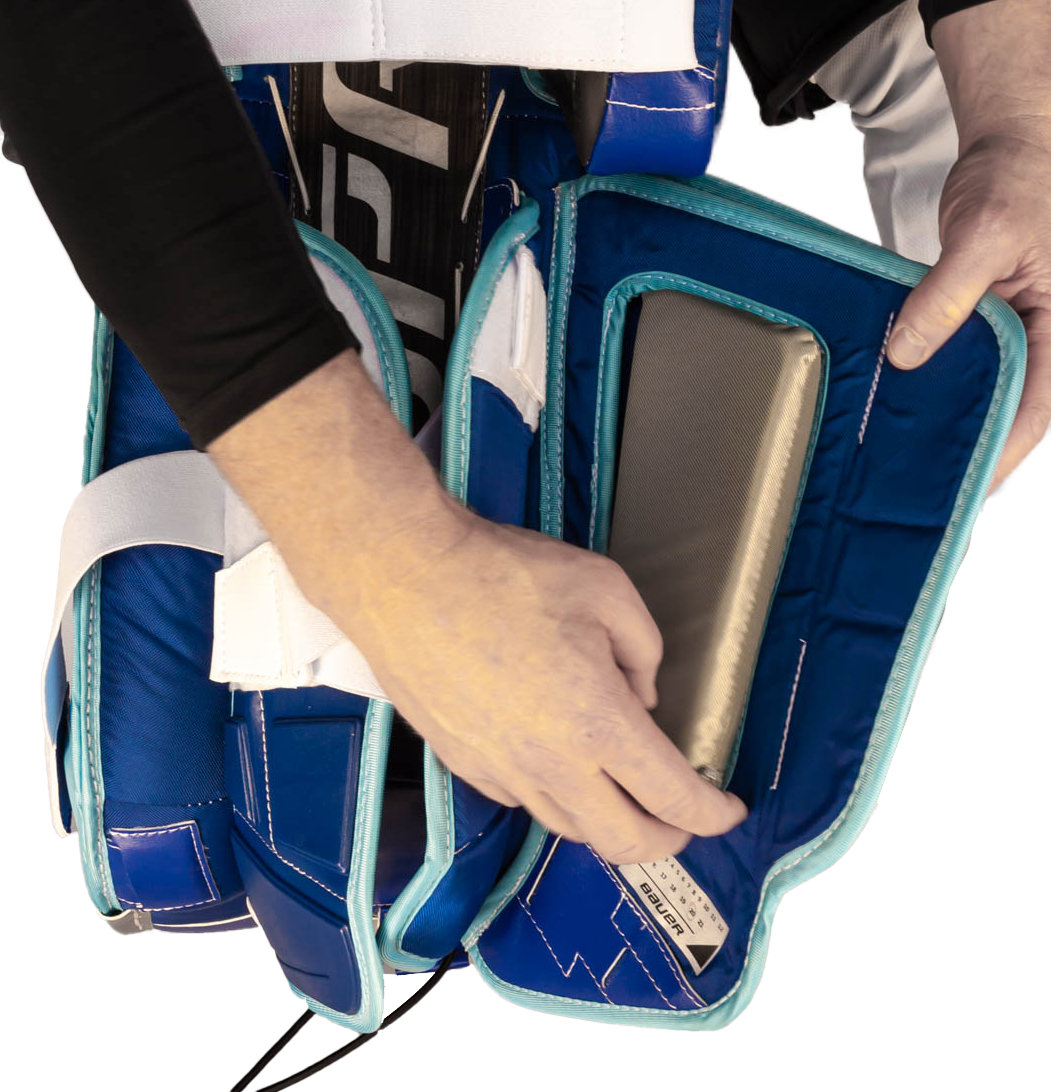
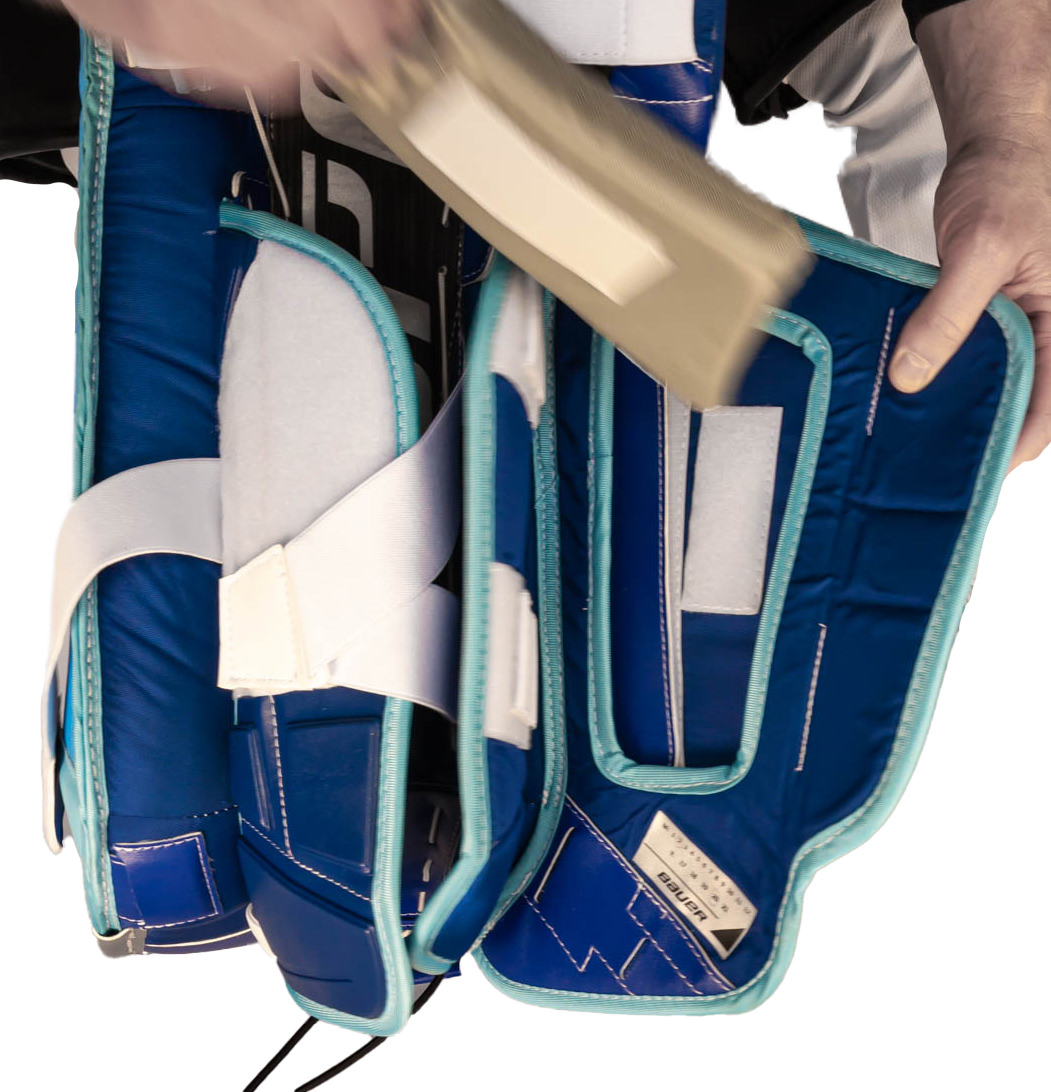
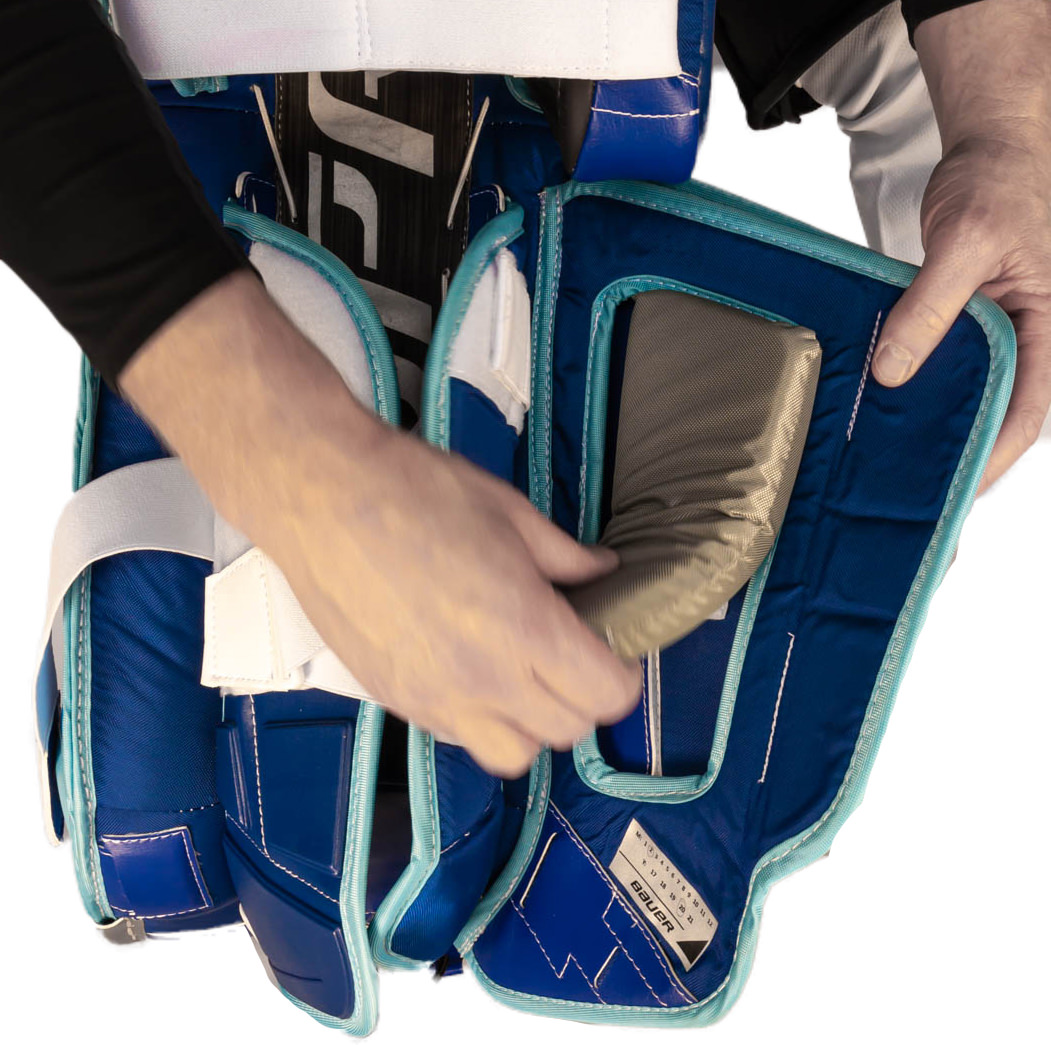
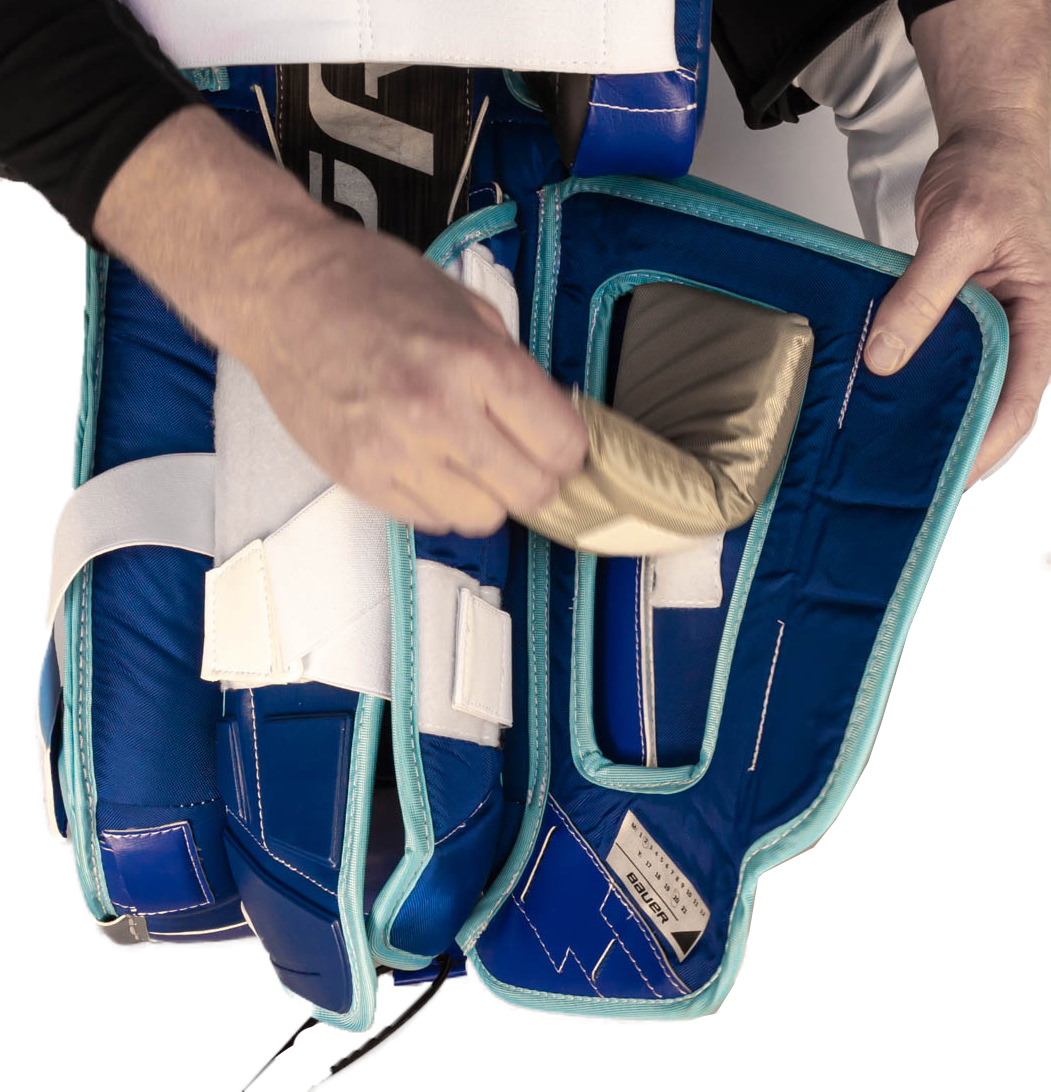
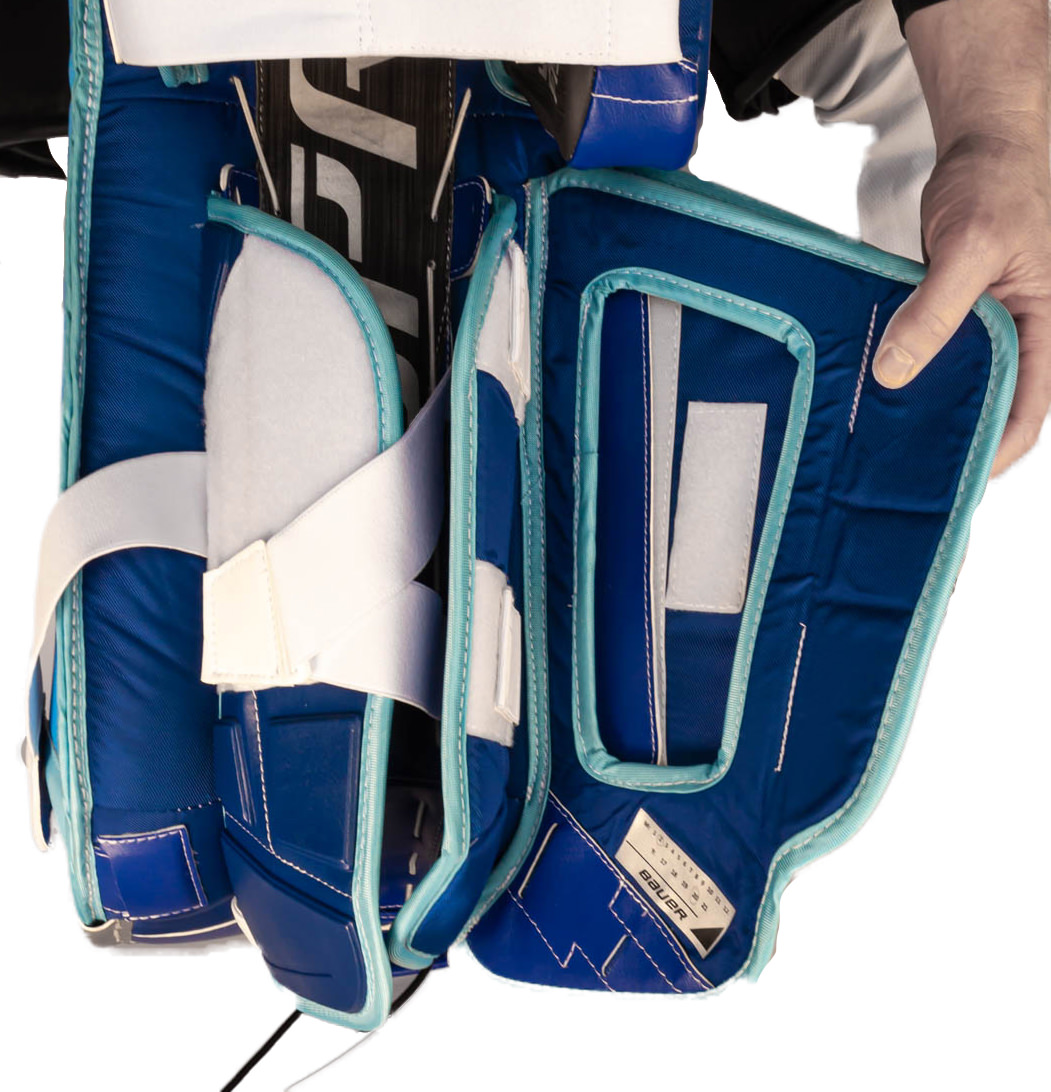

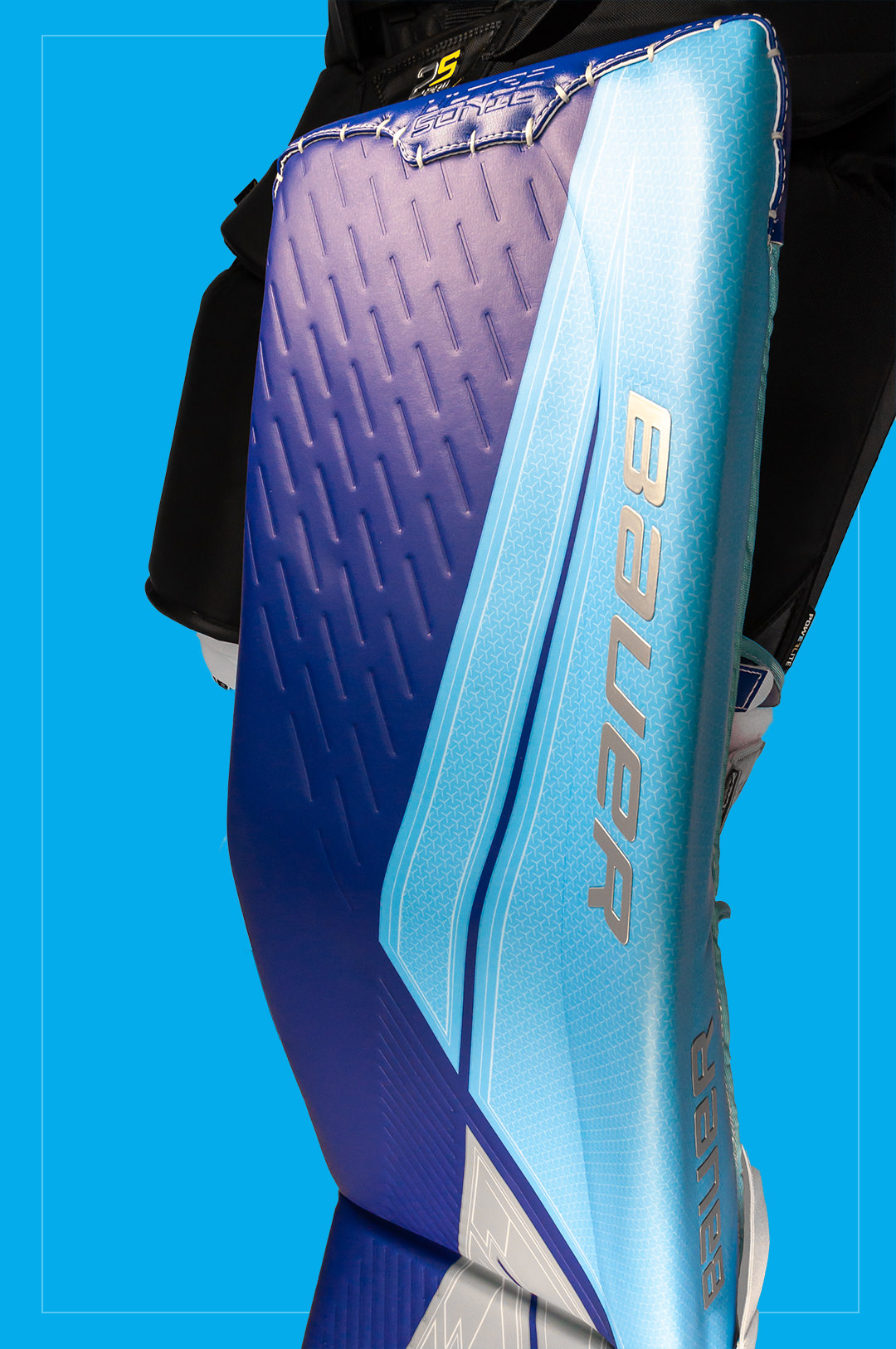

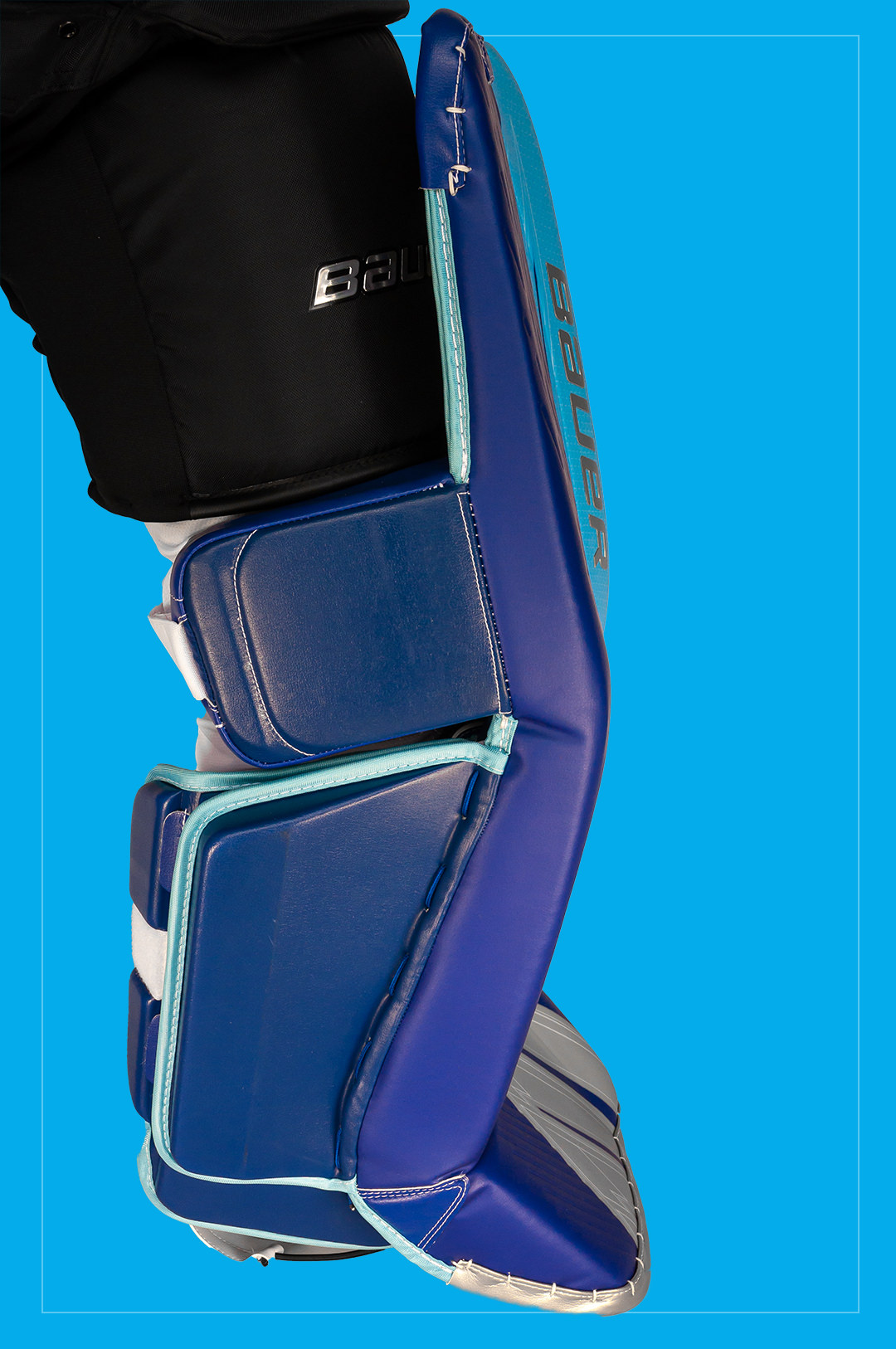
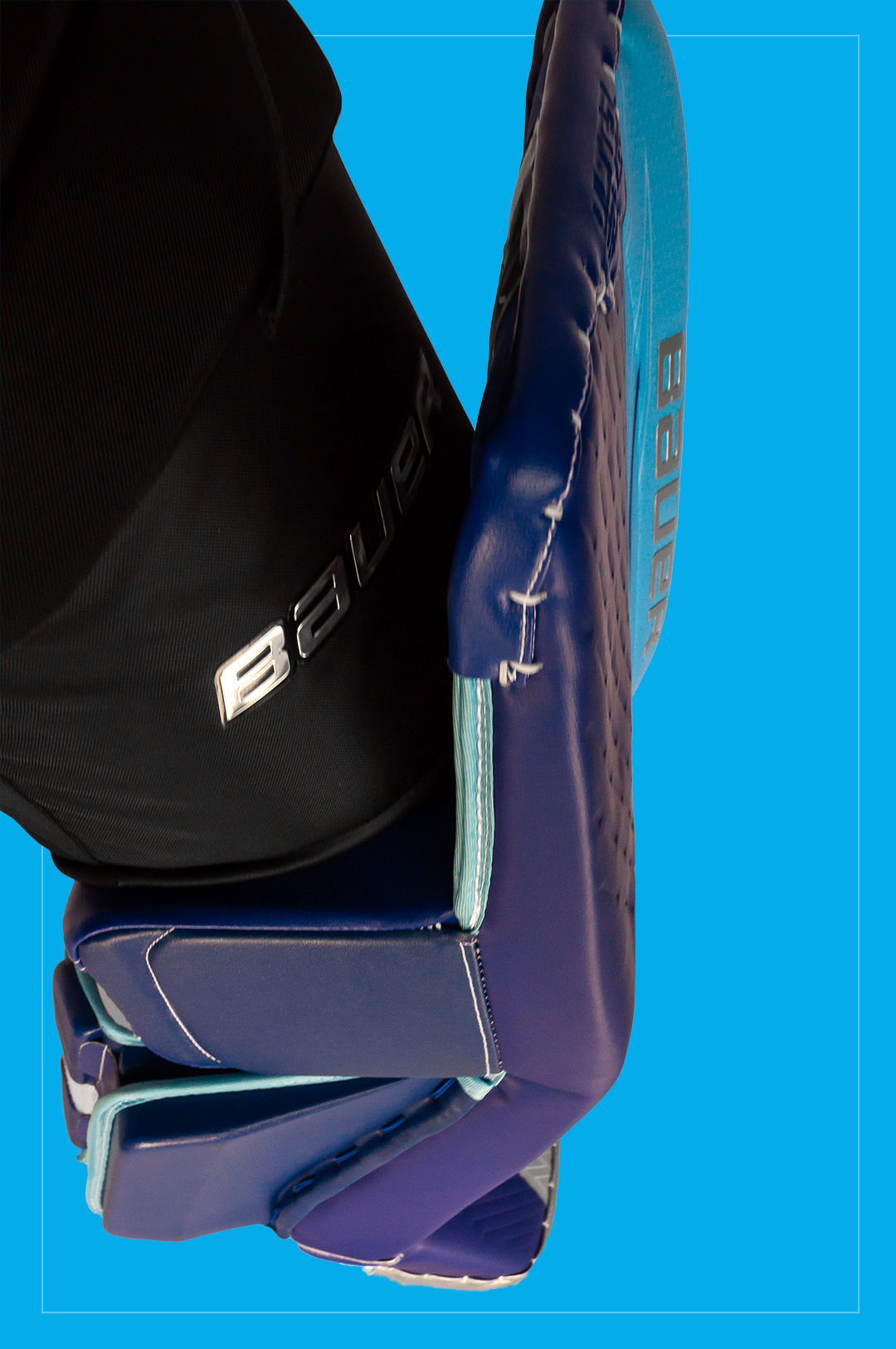
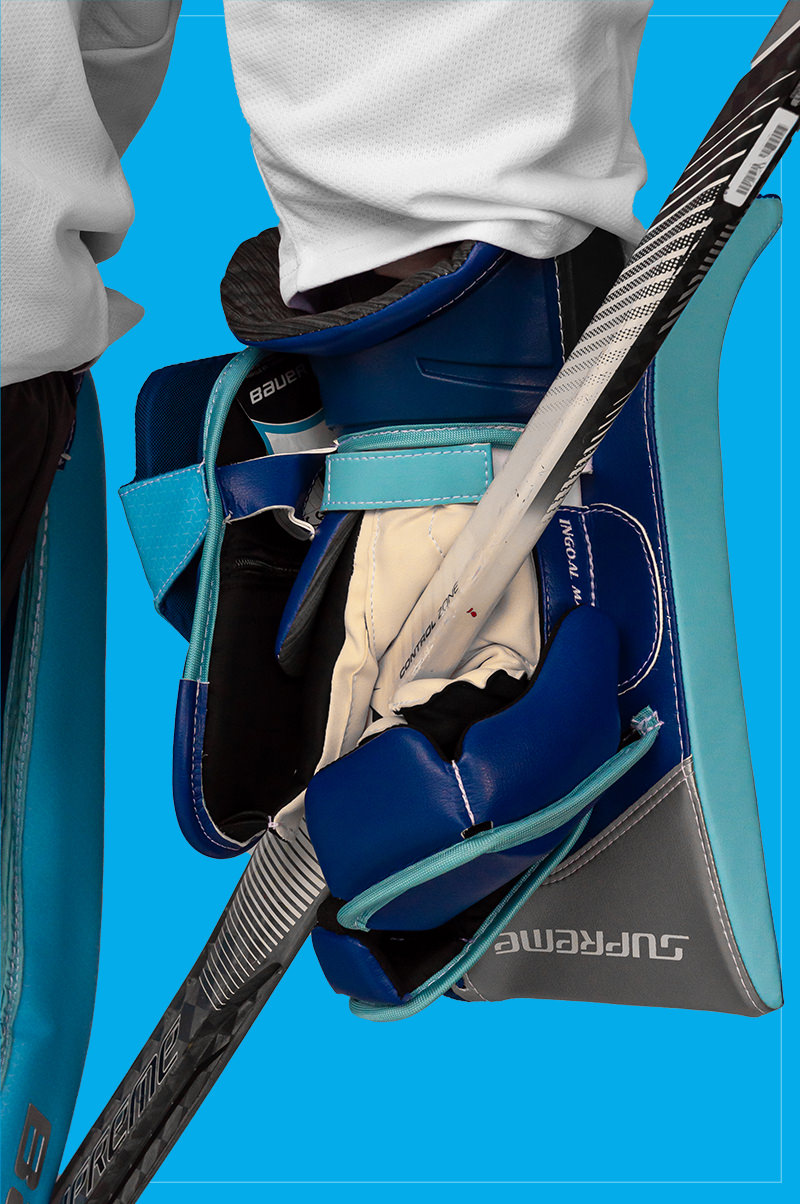
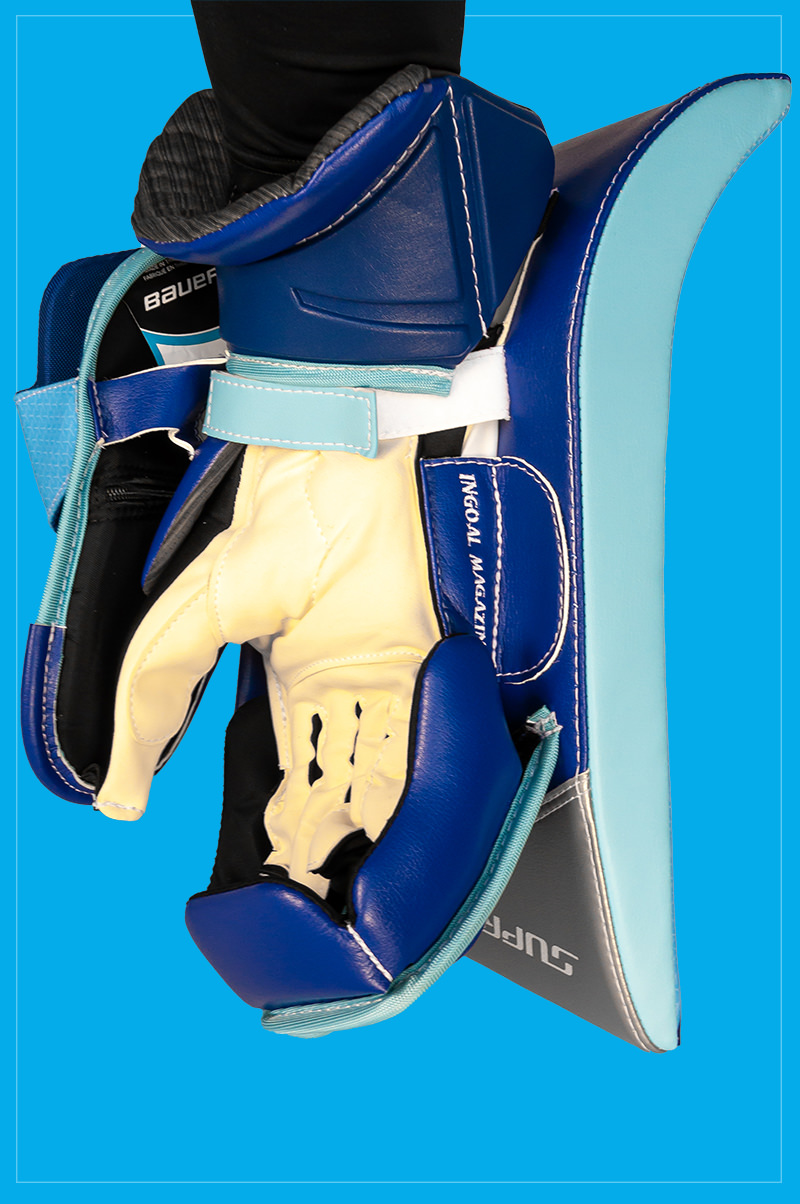
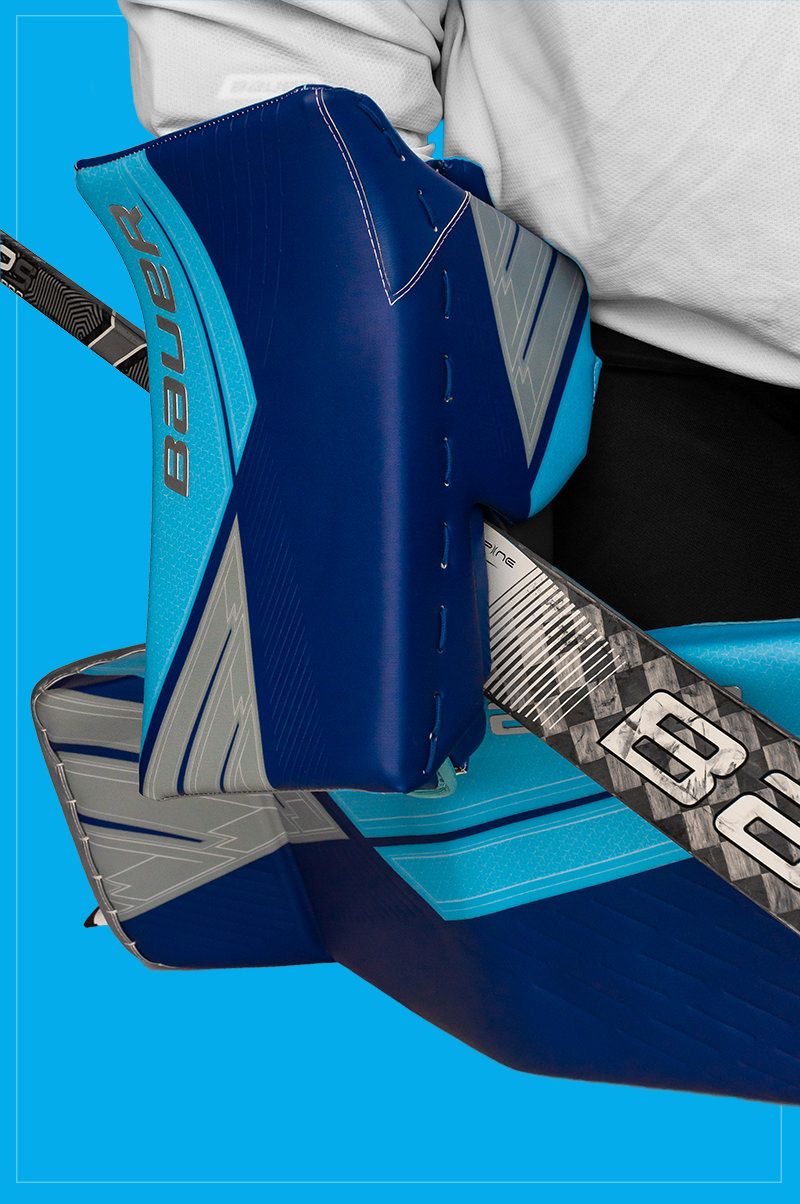
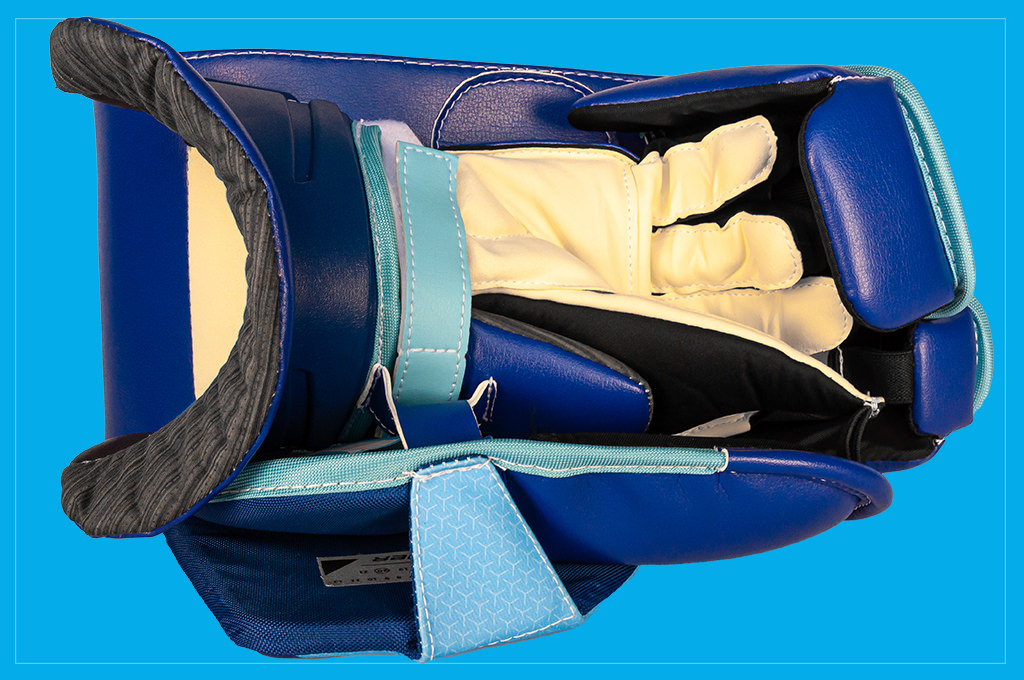
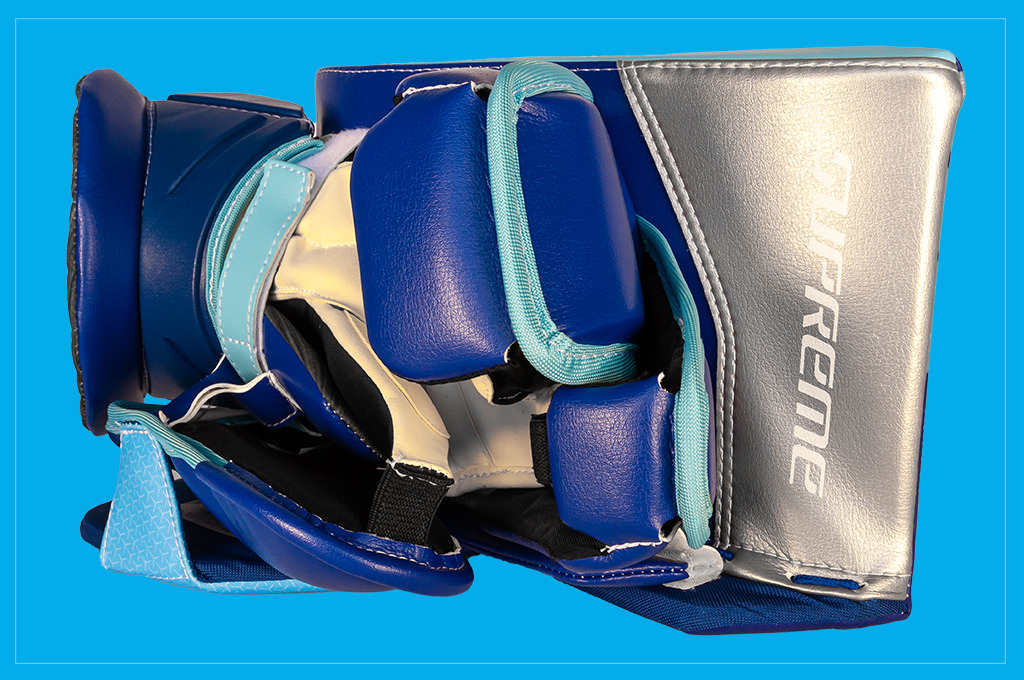
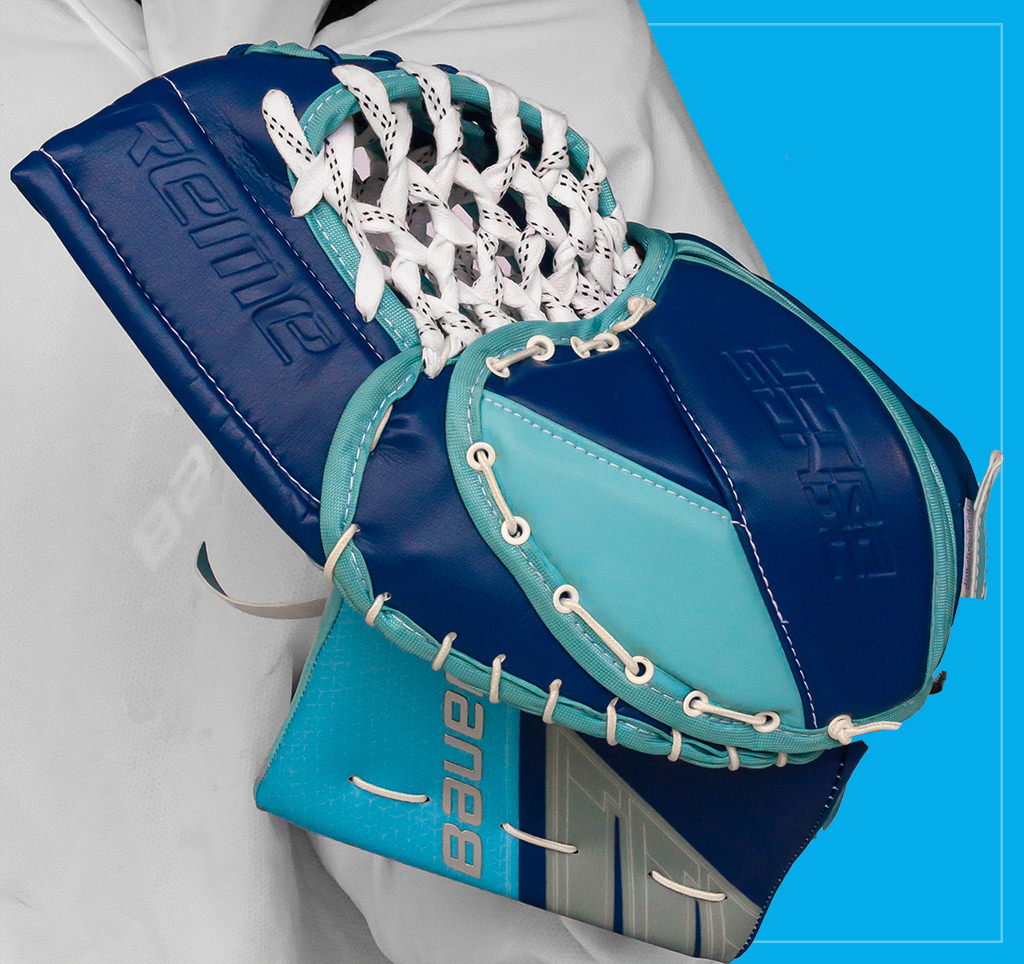
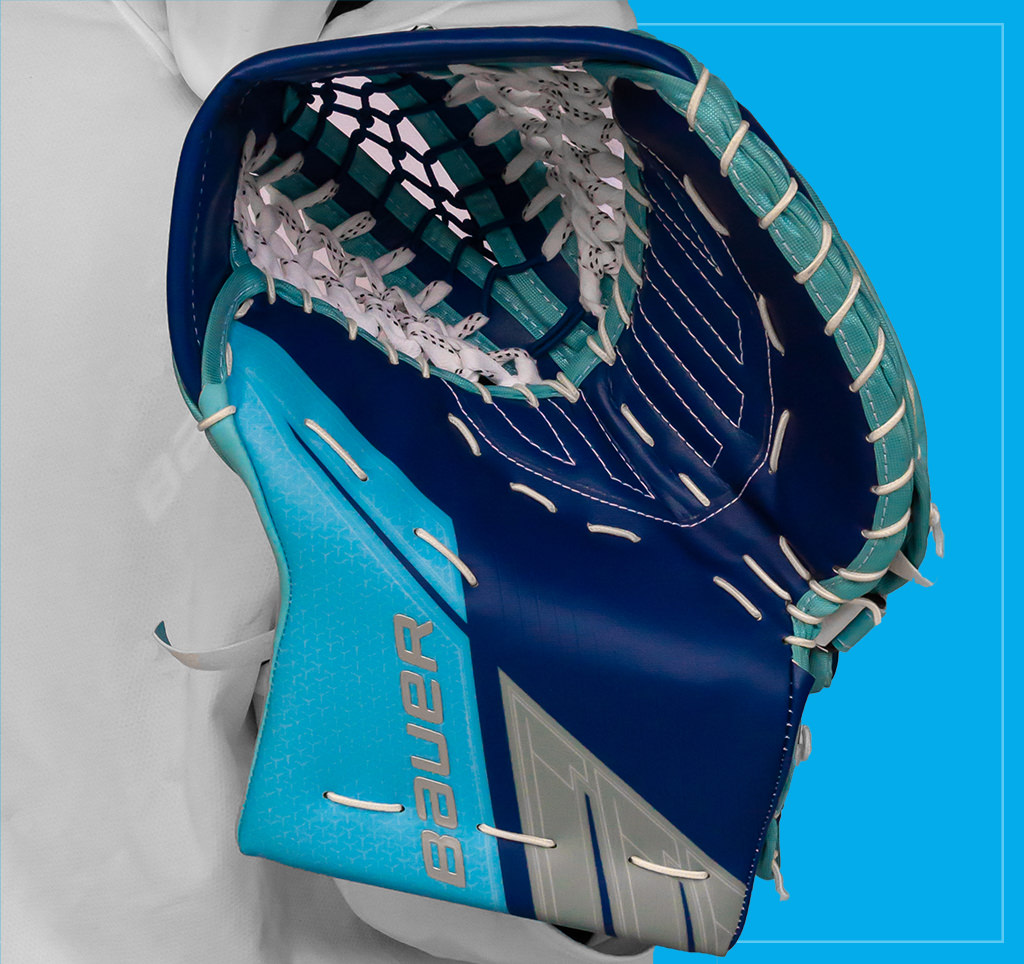

Stock Game-Ready palm? or pro palm? I ordered my set which should be coming in soon with a pro palm, should be interesting!
Ours is stock…generally the case with all our review sets. Enjoy yours when it comes!